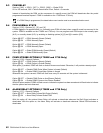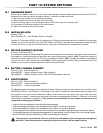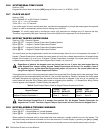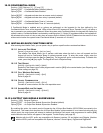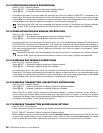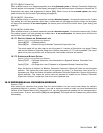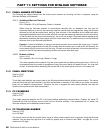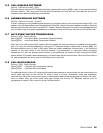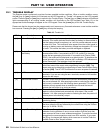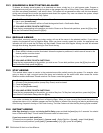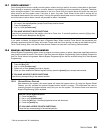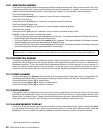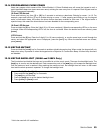
50 REFERENCE & INSTALLATION MANUAL
PART 12: USER OPERATION
12.1 TROUBLE DISPLAY
The Spectra system continuously monitors fourteen possible trouble conditions. When a trouble condition occurs,
the [
TBL] key or [TRBL] indicator will illuminate on the LED keypads or “Trouble” will appear on the LCD keypad’s
screen. Press the [
TBL] or [TRBL] key to switch to the Trouble Display. The [TBL] key or [TRBL] indicator will flash and
lights corresponding to an existing trouble condition will illuminate on the LED keypads (see Table 10) or the
appropriate trouble message will appear on the LCD keypad. Press the [
CLEAR] key to exit the Trouble Display.
Please note that the keypad can be programmed to emit a
BEEP every 5 seconds whenever a new trouble condition
has occurred. Pressing the [
TBL] or [TRBL] key will stop the beeping.
Table 10:
Trouble List
LED # Description Details
[1] No/Low Battery Failure The control panel performs a dynamic battery test under load every 60
seconds. This trouble indicates that the back up battery is disconnected or
that the battery should be replaced, as it will not provide adequate current
in case of AC loss. This trouble will also appear when the control panel is
running on battery power and the battery voltage has dropped to 10.5 volts
or lower. This means the battery must be recharged or replaced.
[2] Wireless Transmitter
Low Battery
The battery voltage of a wireless transmitter has dropped below
recommended limits. If connected to a SPC-319, press [2] to view the
zones that are generating this trouble. If connected to an Omnia (OMN-
RCV3), the trouble will be displayed as a global trouble. To determine the
zones generating the trouble, examine the Low Battery LED indicators on
all the transmitters. The batteries should be replaced.
[3] Power Failure Upon power failure, the AC LED on all keypads will turn off. The control
panel can transmit the report code programmed in section [205]. This
report code can be delayed by programming a Power Failure Report Delay
in section [086]. The AC LED turns back on as soon as power is restored.
[4] Bell Disconnected This trouble occurs when a bell or siren is not connected to the bell output
terminals. If you are not using the
BELL terminals, connect a 1KΩ resistor
across the bell output.
[5] Maximum Bell Current The
BELL output uses a fuseless circuit and will automatically shut down if
the current exceeds 3A. After opening the short or reducing the load, the
bell current is restored upon the following alarm generation. This trouble
indicator will only appear when a condition has occurred that would
activate the bell output (e.g. during an alarm).
[6] Maximum Auxiliary Current The auxiliary output uses a fuseless circuit to protect the power supply
against current overload and automatically shuts down if the current
exceeds 1.1A. After opening the short or reducing the load, the panel will
restore power to the auxiliary output.
[7] Communicator Report Fail The control panel has failed all attempts to communicate with the central
monitoring station.
[8] Timer Loss The control panel’s internal clock must be re-programmed. To re-program
the timer press the [8] key followed by the current time using the 24-hour
clock (i.e. 8:30PM = 20:30).
[9] Tamper/Zone Wiring Fail If the Tamper Recognition options are enabled (see page 30), this trouble
indicates a wiring problem on one or more zones or that the cover has
been removed on one or more wireless transmitters. To provide line short
recognition the zone connections must have EOL resistors. If you press
the [9] key, the keypad will display which zones are in trouble. Enter the
Installer Code to clear Tamper troubles.



